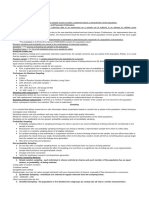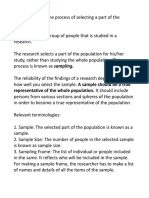0 ratings0% found this document useful (0 votes)
2 viewsModule Three
Uploaded by
abdirasaqadam197Copyright
© © All Rights Reserved
Available Formats
Download as PPTX, PDF, TXT or read online on Scribd
0 ratings0% found this document useful (0 votes)
2 viewsModule Three
Uploaded by
abdirasaqadam197Copyright
© © All Rights Reserved
Available Formats
Download as PPTX, PDF, TXT or read online on Scribd
You are on page 1/ 43
Alpha University Borama
Departments of Nutrition and
PHO
Course title: Biostatistics
Module Three :
Sampling Methods
Learning Objectives
At the end of this Unit, participants
must know:
Sampling
Probability sampling
Non probability sampling
Sampling size determination
Sampling methods
What is Sampling
Sampling is the process of selecting a “few
cases” from target population in order to
provide information that can be used to
make judgments about a much larger
number of cases.
The “few cases” is called the sample, and
the whole group from which the “few
cases” has been drawn is the population or
universe.
The process of obtaining a
representative sample is called
sampling.
Sampling is necessary in research to:
1. Shorten the time.
2. Reduce costs .
3. Gain greater accuracy in data collection and
analysis, since the Few cases involved are easily
analysis.
4. No need to spend resources to study a whole
population when the information can be
obtained from a part of the population.
Sampling Terminology
Target Population: The larger population
(universe) from which a sample has been
drawn and to which the researcher intends
to generalize his or her findings.
Example
• The entire group of people that the
researcher is interested in (children with
HIV, pregnant teenagers…)
Accessible population: An accessible
population is part or a subset of the
target population that a researcher can
actually reach, and from which the
researcher actually draws a sample.
Example
• The population that is available for study
(pregnant mothers at MCH clinic in
Borama).
Sample: Representative part of population.
Element: The unit of analysis about which
data is collected, and that forms the basis
of analysis.
Sampling frame: is a list of all members of
a population.
(hospital admission list, voter registration
list...)
(all members of the population need to be
listed).
Conti..
Random Selection: The process of
picking cases from a target
population without any bias (or by
chance) to represent the population.
Activity
We want to know Quality education providing
Universities in Borama . We get list of all Alpha
University Borama students from the registrar
University and randomly choose 60 students.
Mention;
Target Population
Accessible population
Sample
Sampling frame
What is the target population?
University Students in Borama or
Universities in Borama
What is the accessible population?
Alpha University Students
What is the sample?
60 Students
What is the Sampling Frame?
The List of all Alpha University Students
obtained from the registrar.
Two type of Sampling Method
A. Probability sampling: is a sampling technique
where the samples are gathered in a process that
gives all the individuals in the population equal
chances of being selected.
• Probability (chance)
1) Simple Random Sampling
2) Systematic Random Sampling
3) Stratified Random Sampling
4) Cluster Sampling
5) Multistage sampling
B. Non-Probability Sampling
there is no system in selecting the sample.
The selection depends upon the situation.
1) Convenience
2) Quota sampling
3) Judgment (or Purposive) Sampling
Probability Sampling
Simple Random Sampling
• It is applicable when the population is small,
homogenous and readily available such as
patients coming to hospital or lying in wards.
• Each element has an equal chance of being
chosen
• Most unbiased
• Time consuming
• Need a sampling frame
Conti---
Method of selecting a sample:
Lottery Method
Table of Random Number method
Calculator Computer
Example
Population 100 and Sample 10 Assign a
number to each element of the
population. Take the table of random
numbers and point with eyes closed at
numbers until 10 have been selected.
Cont..
Systematic Random Sampling
Systematic Random Sampling: Individuals are
chosen at regular intervals ( for example, every kth)
from the sampling frame. This interval is called the
sampling interval, is calculated by dividing the
population size by the desired sample size.
• Need list of population
• Determine sample size
• Determine sampling interval (every 5th person)
• Select a random starting point.
• The order of the population list needs to be random
in order for it not to be biased.
Example
For example, a systematic sample is to be
selected from 1200 students of a school.
The sample size is decided to be 100. The
sampling interval is: 1200 /100 = 12.
Hence, the sample interval is 12.
Continue--
• The number of the first student to be
included in the sample is chosen randomly,
for example by blindly picking one out of
twelve pieces of paper, numbered 1 to 12. If
number 6 is picked, every twelfth student
will be included in the sample, starting with
student number 6, until 100 students are
selected. The numbers selected would be
6,18,30,42,etc.
Steps in systematic sampling:
Define the population
Determine the desired sample size
Obtain a list
Determine what K is equal to by dividing the size of
the population by the desired sample size
Select some random place at the top of the population
list
Starting at that point, take every Kth name on the list
until desired sample size is reached
systematic sampling:
• k=?
• population size = 64
• sample size = 8
• K=8
Class Activity
Imagine that a local clothing manufacturer has
2,700 employees. The personnel manager
decides to ask the employees for suggestions on
how to improve their workplace. It would take
too long to survey everyone, so the manager
chooses to systematically sample 300 of the
employees.
1. What would be the sampling interval?
2. If the number 8 was your first randomly drawn
number, what would be the next 5 numbers of
your sample?
Stratified Random Sampling
• Stratified random sampling is a method of
sampling that involves the division of a population
into smaller sub-groups known as strata.
• Stratified random sampling involves dividing the
entire population into homogeneous groups
called strata.
• A common method is to arrange or classify by
gender, age, ethnicity, educational attainment,
income and similar ways. Splitting subjects into
mutually exclusive groups and then using simple
random sampling to choose members from groups.
Cont,..
Cluster Sampling
4.Cluster Sampling: This method is used
when units of population are in natural
groups or clusters such as villages ,wards
and slums.
Strata: Within strata individuals are
homogenous and between strata heterogeneous.
Cluster: Within cluster individuals are
heterogeneous and between cluster
homogeneous.
Continue--
A cluster or an area is any group (geographical)
Cluster sampling is similar to stratified
sampling because in both cases, the main
population is divided into subgroups. However,
they differ in that in a stratified sample,
elements in a stratum are relatively
homogenous and cannot be used to represent
the population. But elements in a cluster
sample are heterogeneous and can be used to
represent the population.
Example
• Population: African people
1. Randomly chose country
2. Randomly chose region
3. Randomly chose city
4. Then subjects are randomly chosen
Example;
It is most often used to evaluate the
vaccination coverage in EPI Progrrame.
Cont…
Multistage sampling
• This method refers to the sampling
procedures carried out in several
stages using random sampling
technique.
• This is employed in large country
survey.
• It enables the use of existing divisions
and districts which saves extra labor.
Non-Probability Sampling
• Convenience Sampling
• In a convenience or accidental sampling method, the
sample is selected from those who happen to be
available at the time of data collection, on a first-come
first served basis, until the desired number is attained.
• The researcher simply picks from those who happen to
be available at the time of data collection, without any
conscious effort to select a particular case or cases, and
without attempting to construct a sampling frame.
• Accidental or incidental sampling
• Choosing whoever is available
Purposive Sampling
• In purposive (or judgmental)
sampling, a researcher uses his or
her knowledge regarding the
population from which information
is to be collected.
Conti--
The researcher uses personal
judgment and logic to select only
those cases that best suit the
purposes of the study.
handpicking” subjects.
Example:
Researching Diabetes: You know a
few patients and friends that are
“typical” diabetics and involve
them in the study.
Quota Sampling
Quota sampling is defined as a non-probability
sampling method in which researchers create a
sample involving individuals that represent a
population. Researchers choose these individuals
according to specific traits or qualities. They
decide and create quotas so that the market
research samples can be useful in collecting data.
These samples can be generalized to the entire
population.
Example
a cigarette company wants to find out
what age group prefers what brand of
cigarettes in a particular city. He/she
applies quotas on the age groups of 21-
30, 31-40, 41-50, and 51+. From this
information, the researcher gauges the
smoking trend among the population of
the city.
Cont….
Determination of sample size
Slovene’s formula
n=N/ (1+ (N*e^2)
where n= sample size,
N= population size,
and E = margin of error or acceptable error
Class Activity
We want to do a survey of employees
of the municipality of Borama on how
to use computers at work if the total
population is 2500 and your
confidence interval is 95%, what will be
the sample size?
Kothari formula
• Kothari formula: n=
• Where: n the desired sample size
• Z: is the z-value corresponding to 95% level of
significance which equals to 1.96
• P: prevalence or expected proportion or percentage
26%
• Q= (1-p) = (1-0.26) = 0.74 and
• d = absolute precision (5%)
CI Z.score
90%=1.645
95%=1.96
99%=2.57
Thank you for your Attention
You might also like
- (Ebook PDF) Statistics For Business and Economics 8th Edition Ebook All Chapters PDF100% (3)(Ebook PDF) Statistics For Business and Economics 8th Edition Ebook All Chapters PDF51 pages
- The Impact of Computer Technology On Accounting System and Its Effect On EmploymNo ratings yetThe Impact of Computer Technology On Accounting System and Its Effect On Employm84 pages
- Describing Sample Size and Sampling Procedures100% (1)Describing Sample Size and Sampling Procedures17 pages
- Classification of Sampling (Probability Based) (Cresswell)100% (1)Classification of Sampling (Probability Based) (Cresswell)33 pages
- 2.0 Methods of Sampling and Their ComparisonNo ratings yet2.0 Methods of Sampling and Their Comparison26 pages
- 07. Sampling and Sample size calculation_2017 (1)No ratings yet07. Sampling and Sample size calculation_2017 (1)48 pages
- Methods of Sampling and Their ComparisonNo ratings yetMethods of Sampling and Their Comparison30 pages
- Research Population, Sample Size & Sampling Methods - Quantitative ResearchNo ratings yetResearch Population, Sample Size & Sampling Methods - Quantitative Research22 pages
- Population Sample and Sampling Techniques (2)No ratings yetPopulation Sample and Sampling Techniques (2)6 pages
- Sampling Design & Different Types of Sampling TechniquesNo ratings yetSampling Design & Different Types of Sampling Techniques41 pages
- BR Chapter 6 - Sample Design and Sampling ProcedureNo ratings yetBR Chapter 6 - Sample Design and Sampling Procedure18 pages
- Statistics Assignment: by Vuyyuri Sujith Varma REG - NO: 17010141138 Bba Sec (A) Sem-2No ratings yetStatistics Assignment: by Vuyyuri Sujith Varma REG - NO: 17010141138 Bba Sec (A) Sem-220 pages
- Q4-PR1-3-Describing Sampling Procedure and SampleNo ratings yetQ4-PR1-3-Describing Sampling Procedure and Sample19 pages
- Sampling: Selecting Certain Number of Study Units From A Defined PopulationNo ratings yetSampling: Selecting Certain Number of Study Units From A Defined Population19 pages
- Sampling in Quantitative Studies: Basic Sampling Concepts 1. PopulationNo ratings yetSampling in Quantitative Studies: Basic Sampling Concepts 1. Population11 pages
- Introduction To Management Chapter One Rift Valley UniversityNo ratings yetIntroduction To Management Chapter One Rift Valley University31 pages
- Lecture PPT Unit 3- Sampling Design Data Collection (1)No ratings yetLecture PPT Unit 3- Sampling Design Data Collection (1)47 pages
- Research - Sampling Methods and TechniquesNo ratings yetResearch - Sampling Methods and Techniques7 pages
- Download Full Proceedings of the Fifth International Conference of Transportation Research Group of India 5th CTRG Volume 2 1st Edition Akhilesh Kumar Maurya PDF All Chapters100% (1)Download Full Proceedings of the Fifth International Conference of Transportation Research Group of India 5th CTRG Volume 2 1st Edition Akhilesh Kumar Maurya PDF All Chapters55 pages
- A Modified Hosmer-Lemeshow Test For Large Data Sets: Communications in Statistics - Theory and MethodsNo ratings yetA Modified Hosmer-Lemeshow Test For Large Data Sets: Communications in Statistics - Theory and Methods26 pages
- Statistics and Probability Formulating Null and Alternative Hypothesis On Population MeanNo ratings yetStatistics and Probability Formulating Null and Alternative Hypothesis On Population Mean17 pages
- BA Module 02 - 2.4 - Confidence IntervalNo ratings yetBA Module 02 - 2.4 - Confidence Interval41 pages
- Chapter One Audit Sampling Chapter Objectives100% (1)Chapter One Audit Sampling Chapter Objectives16 pages
- Complete Download Remote Sensing and GIS Accuracy Assessment Mapping Science 1st Edition Ross S. Lunetta PDF All Chapters100% (7)Complete Download Remote Sensing and GIS Accuracy Assessment Mapping Science 1st Edition Ross S. Lunetta PDF All Chapters57 pages
- Addis Ababa: The Effects of Job Satisfaction On Employees' Turnover IntentionNo ratings yetAddis Ababa: The Effects of Job Satisfaction On Employees' Turnover Intention30 pages
- Validation of The Calibration Procedure in Atomic Absorption Spectrometric MethodsNo ratings yetValidation of The Calibration Procedure in Atomic Absorption Spectrometric Methods10 pages
- A Study of The Lived Experiences of Alternative Learning System LearnersNo ratings yetA Study of The Lived Experiences of Alternative Learning System Learners55 pages
- Impact of External and Internal Factors On Management Accounting Practices: A Study of PakistanNo ratings yetImpact of External and Internal Factors On Management Accounting Practices: A Study of Pakistan13 pages
- A Quasi Experimental Study of Comprehensive Disaster Management ProgramNo ratings yetA Quasi Experimental Study of Comprehensive Disaster Management Program14 pages
- Applied Practical Research 1 q2 Mod5 v2No ratings yetApplied Practical Research 1 q2 Mod5 v230 pages
- Chapter 8 - Estimation and Hypothesis Testing For Two Population Parameters100% (1)Chapter 8 - Estimation and Hypothesis Testing For Two Population Parameters11 pages
- AT.2813 - Determining The Extent of Testing PDFNo ratings yetAT.2813 - Determining The Extent of Testing PDF7 pages
- (Ebook PDF) Statistics For Business and Economics 8th Edition Ebook All Chapters PDF(Ebook PDF) Statistics For Business and Economics 8th Edition Ebook All Chapters PDF
- The Impact of Computer Technology On Accounting System and Its Effect On EmploymThe Impact of Computer Technology On Accounting System and Its Effect On Employm
- Classification of Sampling (Probability Based) (Cresswell)Classification of Sampling (Probability Based) (Cresswell)
- Research Population, Sample Size & Sampling Methods - Quantitative ResearchResearch Population, Sample Size & Sampling Methods - Quantitative Research
- Sampling Design & Different Types of Sampling TechniquesSampling Design & Different Types of Sampling Techniques
- BR Chapter 6 - Sample Design and Sampling ProcedureBR Chapter 6 - Sample Design and Sampling Procedure
- Statistics Assignment: by Vuyyuri Sujith Varma REG - NO: 17010141138 Bba Sec (A) Sem-2Statistics Assignment: by Vuyyuri Sujith Varma REG - NO: 17010141138 Bba Sec (A) Sem-2
- Sampling: Selecting Certain Number of Study Units From A Defined PopulationSampling: Selecting Certain Number of Study Units From A Defined Population
- Sampling in Quantitative Studies: Basic Sampling Concepts 1. PopulationSampling in Quantitative Studies: Basic Sampling Concepts 1. Population
- Introduction To Management Chapter One Rift Valley UniversityIntroduction To Management Chapter One Rift Valley University
- Lecture PPT Unit 3- Sampling Design Data Collection (1)Lecture PPT Unit 3- Sampling Design Data Collection (1)
- Download Full Proceedings of the Fifth International Conference of Transportation Research Group of India 5th CTRG Volume 2 1st Edition Akhilesh Kumar Maurya PDF All ChaptersDownload Full Proceedings of the Fifth International Conference of Transportation Research Group of India 5th CTRG Volume 2 1st Edition Akhilesh Kumar Maurya PDF All Chapters
- A Modified Hosmer-Lemeshow Test For Large Data Sets: Communications in Statistics - Theory and MethodsA Modified Hosmer-Lemeshow Test For Large Data Sets: Communications in Statistics - Theory and Methods
- Statistics and Probability Formulating Null and Alternative Hypothesis On Population MeanStatistics and Probability Formulating Null and Alternative Hypothesis On Population Mean
- Complete Download Remote Sensing and GIS Accuracy Assessment Mapping Science 1st Edition Ross S. Lunetta PDF All ChaptersComplete Download Remote Sensing and GIS Accuracy Assessment Mapping Science 1st Edition Ross S. Lunetta PDF All Chapters
- Addis Ababa: The Effects of Job Satisfaction On Employees' Turnover IntentionAddis Ababa: The Effects of Job Satisfaction On Employees' Turnover Intention
- Validation of The Calibration Procedure in Atomic Absorption Spectrometric MethodsValidation of The Calibration Procedure in Atomic Absorption Spectrometric Methods
- A Study of The Lived Experiences of Alternative Learning System LearnersA Study of The Lived Experiences of Alternative Learning System Learners
- Impact of External and Internal Factors On Management Accounting Practices: A Study of PakistanImpact of External and Internal Factors On Management Accounting Practices: A Study of Pakistan
- A Quasi Experimental Study of Comprehensive Disaster Management ProgramA Quasi Experimental Study of Comprehensive Disaster Management Program
- Chapter 8 - Estimation and Hypothesis Testing For Two Population ParametersChapter 8 - Estimation and Hypothesis Testing For Two Population Parameters

























































































